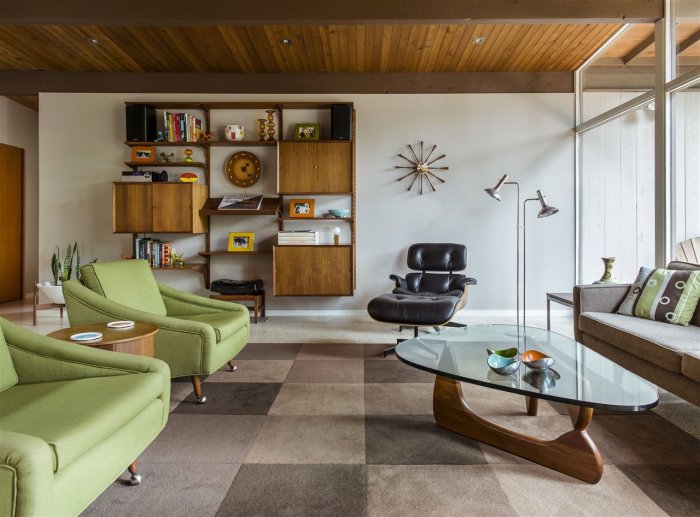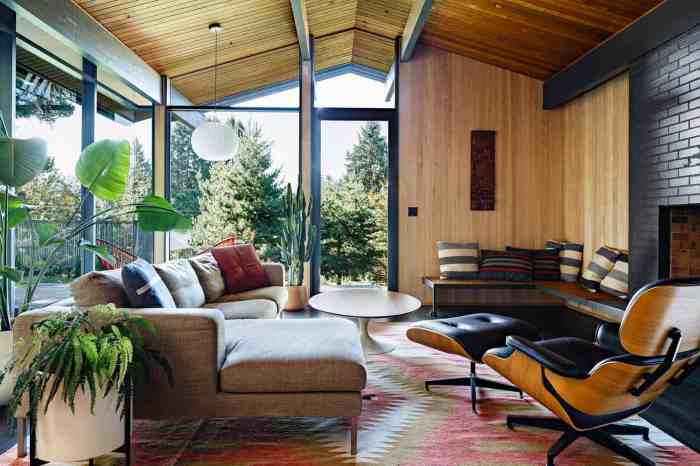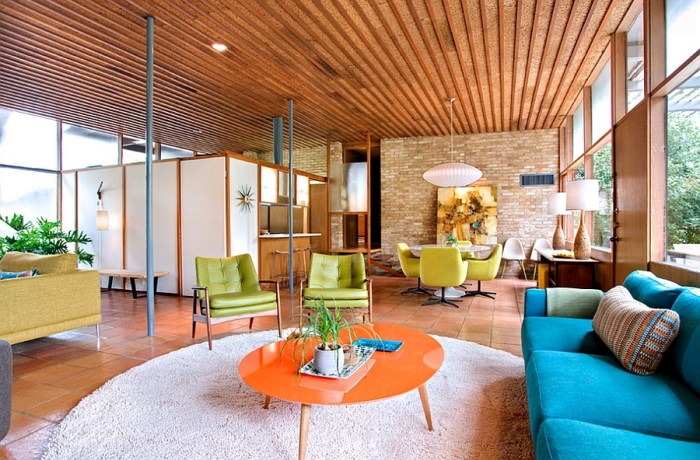1960s house interior design was a vibrant era of bold experimentation, influenced by the rise of modernism and the post-war economic boom. Homes embraced clean lines, geometric shapes, and natural materials, reflecting a shift towards functionality and simplicity.
The decade’s design aesthetic was characterized by a playful use of color and pattern, incorporating bold primary colors, earth tones, and pastels. Geometric prints, floral motifs, and abstract designs adorned furniture, fabrics, and wallpaper, creating a dynamic and eclectic atmosphere.
The Rise of Mid-Century Modern

The 1960s saw a dramatic shift in interior design, marked by the rise of Mid-Century Modern style. This period was a fusion of post-war optimism, technological advancements, and a yearning for a new aesthetic that reflected the changing times. The design choices of this era were heavily influenced by the burgeoning modernist movement and the economic boom that followed World War II.
The Influence of Modernism, 1960s house interior design
Modernism, a design philosophy that emerged in the early 20th century, emphasized functionality, simplicity, and a rejection of ornamentation. It sought to create clean, uncluttered spaces that were both aesthetically pleasing and practical. The 1960s witnessed the widespread adoption of modernist principles in interior design, leading to the emergence of Mid-Century Modern.
This style embraced the use of clean lines, geometric shapes, and a focus on natural materials.
The Post-War Economic Boom
The post-war economic boom fueled the growth of the middle class and created a demand for new homes and furniture. This economic prosperity also allowed for greater experimentation in design, leading to the development of new materials and technologies. The availability of new materials, such as plastics and laminates, allowed designers to create furniture with bold shapes and vibrant colors.
Key Design Elements of Mid-Century Modern
- Clean Lines and Geometric Shapes:Mid-Century Modern furniture is characterized by its simple, clean lines and geometric shapes. This focus on form over ornamentation was a direct result of the influence of modernism.
- Natural Materials:The use of natural materials like wood, leather, and wool was central to Mid-Century Modern. These materials provided a sense of warmth and authenticity, contrasting with the cold, industrial feel of earlier modern designs.
- Bold Colors and Patterns:While the overall aesthetic of Mid-Century Modern was minimalist, the use of bold colors and patterns added a touch of vibrancy and personality. The use of bright hues like mustard yellow, turquoise, and orange, often paired with geometric patterns, created a dynamic and playful atmosphere.
- Functionality:Mid-Century Modern furniture was designed with functionality in mind. Pieces were often multi-purpose, serving both aesthetic and practical needs. For example, a sofa might also double as a bed, or a coffee table could be used as a storage unit.
The 1960s saw a shift in home design, embracing bold colors, geometric shapes, and a focus on functionality. While space was often at a premium in homes of that era, designers today often incorporate similar elements in modern homes, even when working with larger spaces.
For instance, a well-planned layout can maximize the use of a 1500 sq ft house interior design 1500 sq ft house interior design , bringing a touch of 1960s flair to contemporary living.
Color Palette and Patterns: 1960s House Interior Design

The 1960s saw a vibrant explosion of color and pattern in interior design, reflecting the era’s optimism and desire for a break from the past. This section delves into the distinctive color palettes and patterns that defined the decade’s aesthetic.
Dominant Color Palettes
The 1960s witnessed a departure from the muted tones of the previous era, embracing a bolder and more expressive use of color. The dominant color palettes of the 1960s were characterized by:
- Bold Primary Colors:The primary colors – red, yellow, and blue – were used extensively in furniture, fabrics, and walls. This bold use of primary colors brought energy and vibrancy to interiors. Examples include the use of bright red accent chairs, yellow walls, and blue geometric patterns in upholstery.
The 1960s saw a surge in bold and geometric patterns, often incorporating vibrant colors like orange and turquoise. This style can still be seen in modern homes, especially in smaller spaces like a 1 bhk house, where 1 bhk house interior design often utilizes clever tricks to maximize space and create a sense of openness.
A 1960s inspired 1 bhk house might feature a vibrant accent wall, geometric rugs, and a mix of vintage and modern furniture, creating a unique and retro-chic atmosphere.
- Earth Tones:Natural hues like brown, green, and beige were also popular, providing a grounding element to the more vibrant primary colors. These earth tones were often incorporated into furniture pieces like wood cabinets and sofas, creating a sense of warmth and stability.
The 1960s saw a dramatic shift in interior design, embracing bold colors, geometric patterns, and a more casual, functional approach. This contrasted sharply with the elegance and formality of the previous era, such as the 1920s house interior design , which favored Art Deco motifs and luxurious materials.
While the 1960s embraced a more minimalist aesthetic, it still showcased a distinct personality through the use of vibrant hues and playful textures.
- Pastels:Soft, muted shades like peach, mint green, and lavender were used to create a sense of tranquility and sophistication. These pastels were often used in bedrooms and living rooms, adding a touch of elegance to the overall design.
Popular Patterns
The 1960s saw a wide range of patterns used in furniture, fabrics, and wallpaper, adding visual interest and personality to interiors.
- Geometric Prints:Geometric patterns like squares, circles, and triangles were very popular, reflecting the era’s fascination with modernism and abstract art. These patterns were often used in upholstery, rugs, and wallpaper, creating a visually stimulating and dynamic atmosphere.
- Floral Motifs:Floral patterns were also widely used, but with a modern twist. Instead of traditional floral prints, 1960s designs often featured stylized and abstract floral motifs, adding a touch of whimsy and elegance to interiors.
- Abstract Designs:Abstract patterns, inspired by the art movement of the time, were frequently used in fabrics and wallpaper. These designs often featured bold colors and geometric shapes, creating a sense of movement and dynamism.
Wrap-Up
![]()
The legacy of 1960s interior design continues to inspire contemporary styles, with its emphasis on functionality, clean lines, and the use of natural materials. Modern designers often reinterpret elements of this era, blending vintage charm with modern sensibilities to create unique and stylish spaces.
Whether it’s the iconic Eames chair, the bold use of color, or the embrace of modular furniture, the 1960s continue to offer a timeless blueprint for creating homes that are both functional and aesthetically pleasing.
FAQ Resource
What are some popular 1960s furniture styles?
Danish modern, Italian design, and American mid-century modern were prominent styles. These styles emphasized clean lines, modular furniture, and iconic chairs like the Eames Lounge Chair and the Barcelona Chair.
How did technology influence 1960s interior design?
The rise of television and the space race inspired designs for entertainment centers, furniture, and decor. For example, the “space age” aesthetic embraced futuristic shapes and materials.
Where can I find inspiration for 1960s interior design?
Explore vintage magazines, design blogs, and online resources dedicated to mid-century modern design. You can also visit museums and galleries showcasing 1960s furniture and decor.




